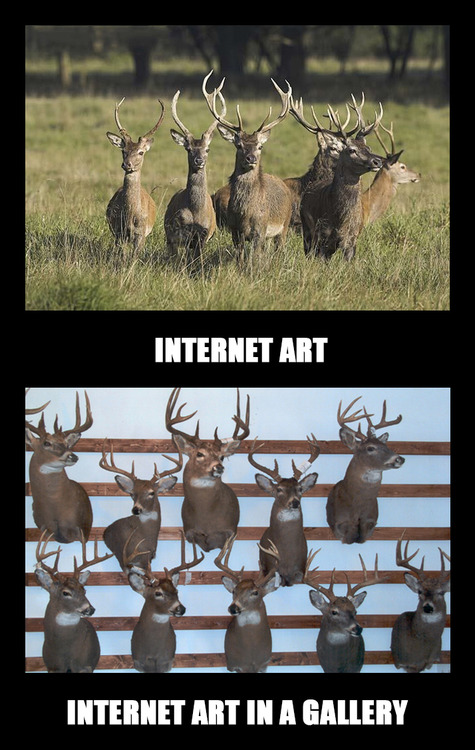What Is Post Internet Art?
To the uninitiated, Post Internet art might seem like art “after the internet”, which isn’t inherently true. Like post-modernists, adapted and expanded on modernism, Post Internet Artists are using the internet to comment on complex issues and ideas.
Post Internet Art is used to critique and explore AI.
post-Internet artists have moved beyond making work dependent on the novelty of the Web to using its tools to tackle other subjects…frequently uses digital strategies to create objects that exist in the real world.
“Post-Internet Art” is a term coined by artist Marisa Olson and developed further by writer Gene McHugh in the critical blog “Post Internet” during its activity between December 2009 and September 2010. Under McHugh’s definition it concerns “art responding to [a condition] described as ‘Post Internet’–when the Internet is less a novelty and more a banality. Perhaps … closer to what Guthrie Lonergan described as ‘Internet Aware’–or when the photo of the art object is more widely dispersed [&] viewed than the object itself.” There are also several references to the idea of “post-net culture” in the writings of Lev Manovich as early as 2001.
Expands Past the Virtual Medium
Of course, both Cortright and Rafman also produce real-world artworks, objects that can be hung on the wall or placed on a plinth in a gallery; the most counterintuitive aspect of the post-Internet label is that it extends to work in the traditional formats of painting and sculpture. In fact, one of the features that distinguishes post-Interent art from the “Net Art” of the late ’90s and early 2000s is its ability to crossover between online and offline formats. While Net Art refers to art that uses the Internet as its medium and cannot be experienced any other way, post-Internet art makes the leap from the screen into brick-and-mortar galleries.
Essential Reading
Books
New Aesthetic, New Anxieties - critical response to discussion surrounding the Post Internet Art movement.
Essays
”The Image Object Post-Internet” - Artie Vierkant 2010 essay
Talks
D I G I T A L - L O C A L - Abby Pusz Internet art panel discussion SXSW 2012
Blogs
The New Aesthetic - James Brindle 9 Eyes - Jon Rafman Post Internet - Gene McHugh
Where Post Internet Art belongs
From Anthony Antonellis’ writing, “Internet art in a gallery”.
 Antonellis argues that Internet Art should be viewed in a holodeck, or it’s natural habitat, browser tabs and windows. Browser tabs are like framed paintings. Viewing internet artwork at home situates you into a relationship with the artist, as they have probably sat in the same position as you creating the work. Internet artwork in a gallery “adapts the work at the expense of this intimacy”. Gallery presents a unique chance to do something different with the work.
Antonellis argues that Internet Art should be viewed in a holodeck, or it’s natural habitat, browser tabs and windows. Browser tabs are like framed paintings. Viewing internet artwork at home situates you into a relationship with the artist, as they have probably sat in the same position as you creating the work. Internet artwork in a gallery “adapts the work at the expense of this intimacy”. Gallery presents a unique chance to do something different with the work.
Final consensus here:
- Taking online work and presenting it with a monitor, keyboard, and mouse doesn’t cut it.
- Don’t seek to make a simple documentation of what already exists online.
- Internet art can “manifest and be articulated in site specific ways”.
Quote
The gallery could be treated like another software platform to explore instead of a net art fridge door.
The Post Internet Artists
LIST FROM #artist AND #post-internet-art